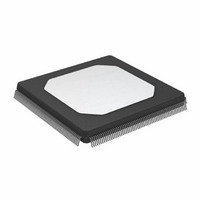ADSP-21060KS-160 Analog Devices Inc, ADSP-21060KS-160 Datasheet - Page 9

ADSP-21060KS-160
Manufacturer Part Number
ADSP-21060KS-160
Description
Digital Signal Processor IC
Manufacturer
Analog Devices Inc
Series
SHARC®r
Type
Floating Pointr
Datasheets
1.ADSP-21062KSZ-133.pdf
(64 pages)
2.ADSP-21060KS-160.pdf
(47 pages)
3.ADSP-21060KS-160.pdf
(64 pages)
Specifications of ADSP-21060KS-160
Supply Voltage Max
5.25V
Dsp Type
Fixed / Floating Point
Mounting Type
Surface Mount
Package / Case
240-MQFP
Memory Organization - Ram
4M
Rohs Status
RoHS non-compliant
Interface
Host Interface, Link Port, Serial Port
Clock Rate
40MHz
Non-volatile Memory
External
On-chip Ram
512kB
Voltage - I/o
5.00V
Voltage - Core
5.00V
Operating Temperature
0°C ~ 85°C
Device Core Size
32b
Architecture
Super Harvard
Format
Floating Point
Clock Freq (max)
40MHz
Mips
40
Device Input Clock Speed
40MHz
Ram Size
512KB
Operating Supply Voltage (typ)
5V
Operating Supply Voltage (min)
4.75V
Operating Supply Voltage (max)
5.25V
Operating Temp Range
0C to 85C
Operating Temperature Classification
Commercial
Mounting
Surface Mount
Pin Count
240
Package Type
MQFP
Lead Free Status / Rohs Status
Not Compliant
Available stocks
Company
Part Number
Manufacturer
Quantity
Price
Company:
Part Number:
ADSP-21060KS-160
Manufacturer:
AD
Quantity:
5 510
Company:
Part Number:
ADSP-21060KS-160
Manufacturer:
SHARP
Quantity:
5 510
Company:
Part Number:
ADSP-21060KS-160
Manufacturer:
Analog Devices Inc
Quantity:
10 000
Pin
SBTS
IRQ
FLAG
TIMEXP
HBR
HBG
CS
REDY (O/D) O
DMAR1
DMAR2
DMAG1
DMAG2
BR
ID
RPBA
CPA (O/D)
DTx
DRx
TCLKx
RCLKx
2-0
6-1
2-0
3-0
Type
I/S
I/A
I/O/A
O
I/A
I/O
I/A
I/A
I/A
O/T
O/T
I/O/S
I
I/S
I/O
O
I
I/O
I/O
Function
Suspend Bus Three-State. External devices can assert SBTS (low) to place the external bus address,
data, selects and strobes in a high impedance state for the following cycle. If the ADSP-2106x
attempts to access external memory while SBTS is asserted, the processor will halt and the memory
access will not be completed until SBTS is deasserted. SBTS should only be used to recover from host
processor/ADSP-2106x deadlock, or used with a DRAM controller.
Interrupt Request Lines. May be either edge-triggered or level-sensitive.
Flag Pins. Each is configured via control bits as either an input or output. As an input, it can be
tested as a condition. As an output, it can be used to signal external peripherals.
Timer Expired. Asserted for four cycles when the timer is enabled and TCOUNT decrements to
zero.
Host Bus Request. Must be asserted by a host processor to request control of the ADSP-2106x’s
external bus. When HBR is asserted in a multiprocessing system, the ADSP-2106x that is bus master
will relinquish the bus and assert HBG. To relinquish the bus, the ADSP-2106x places the address,
data, select and strobe lines in a high impedance state. HBR has priority over all ADSP-2106x bus
requests (BR
Host Bus Grant. Acknowledges an HBR bus request, indicating that the host processor may take
control of the external bus. HBG is asserted (held low) by the ADSP-2106x until HBR is released. In a
multiprocessing system, HBG is output by the ADSP-2106x bus master and is monitored by all others.
Chip Select. Asserted by host processor to select the ADSP-2106x.
Host Bus Acknowledge. The ADSP-2106x deasserts REDY (low) to add wait states to an asynchro-
nous access of its internal memory or IOP registers by a host. Open drain output (O/D) by default; can
be programmed in ADREDY bit of SYSCON register to be active drive (A/D). REDY will only be
output if the CS and HBR inputs are asserted.
DMA Request 1 (DMA Channel 7).
DMA Request 2 (DMA Channel 8).
DMA Grant 1 (DMA Channel 7).
DMA Grant 2 (DMA Channel 8).
Multiprocessing Bus Requests. Used by multiprocessing ADSP-2106xs to arbitrate for bus master-
ship. An ADSP-2106x only drives its own BRx line (corresponding to the value of its ID
monitors all others. In a multiprocessor system with less than six ADSP-2106xs, the unused BRx pins
should be pulled high; the processor’s own BRx line must not be pulled high or low because it is an
output.
Multiprocessing ID. Determines which multiprocessing bus request (BR1 – BR6) is used by ADSP-
2106x. ID = 001 corresponds to BR1, ID = 010 corresponds to BR2, etc. ID = 000 in single-processor
systems. These lines are a system configuration selection which should be hardwired or only changed
at reset.
Rotating Priority Bus Arbitration Select. When RPBA is high, rotating priority for multiprocessor
bus arbitration is selected. When RPBA is low, fixed priority is selected. This signal is a system con-
figuration selection which must be set to the same value on every ADSP-2106x. If the value of RPBA is
changed during system operation, it must be changed in the same CLKIN cycle on every ADSP-2106x.
Core Priority Access. Asserting its CPA pin allows the core processor of an ADSP-2106x bus slave
to interrupt background DMA transfers and gain access to the external bus. CPA is an open drain
output that is connected to all ADSP-2106xs in the system. The CPA pin has an internal 5 kΩ pull-up
resistor. If core access priority is not required in a system, the CPA pin should be left unconnected.
Data Transmit (Serial Ports 0, 1). Each DT pin has a 50 kΩ internal pull-up resistor.
Data Receive (Serial Ports 0, 1). Each DR pin has a 50 kΩ internal pull-up resistor.
Transmit Clock (Serial Ports 0, 1). Each TCLK pin has a 50 kΩ internal pull-up resistor.
Receive Clock (Serial Ports 0, 1). Each RCLK pin has a 50 kΩ internal pull-up resistor.
6-1
) in a multiprocessing system.
ADSP-21060/ADSP-21060L
2-0
inputs) and













